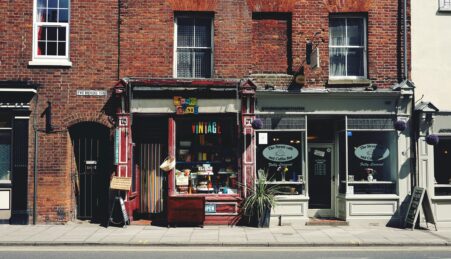Music and Gothic culture aficionados John Robb (Membranes, Louder Than War) and Dr Claire Nally (Northumbria University) chair a full and frank discussion on the Gothic past and Goth in the 21st Century.
By Emily Oldfield
A unique in-conversation event between Dr. Claire Nally and John Robb took place this week as part of Gothic Manchester Festival 2017. The evening delved deep into the Gothic genre, subcultures and related forms including music and art.
Hosted at the innovative arts space the Three Minute Theatre on the ground floor of Afflecks Palace in Manchester’s Northern Quarter, the two contemporary experts on the Gothic considered past and present notions of the term.
Arranged in coordination with the Manchester Centre for Gothic Studies at the Manchester Writing School, the event was organised in partnership with Manchester Met’s Research in Arts and Humanities programme (RAH!).
John Robb is a notable musician – particularly known for his work in the Membranes and Goldblade – and has almost finished writing his book The Art of Darkness, which is set to be an in-depth examination of the darker elements of post-punk and Goth culture.
He shared his experiences of the Gothic with Humanity Hallows ahead of the event:
“Who can resist such powerful and thrilling themes such as sex and death? Who can bare the pastel shades of modern culture? With its thrilling soundtrack that was far more experimental and funky than surrounding music at the time but with a delicious darkness goth culture was always called post-punk before it got mislabelled.
“Much misunderstood the so-called Gothic strand that came out of post-punk was an embrace of the darker undertow of the times and a tapping into the deep damp… Melancholia that is at the heart of European culture.”
While John Robb was approaching the topic from a more musical angle, and raising the interesting issue that ‘Goth’ is perhaps more punk than may be first thought– even reflecting on the processes of urbanism and the impact of subcultures on ‘small towns’ – Dr. Claire Nally provided insight into the study of gender and identity, especially considering her role as Senior Lecturer in Twentieth-Century English Literature at Northumbria University.
The discussion was chaired by Director of the Manchester Centre for Gothic Studies Dr. Linnie Blake, who asked insightful questions, leading the speakers to discuss the possible definitions of Gothic.
“There is no such one thing as ‘Goth’,” John raised evocatively early in the conversation, as he sat on a sofa next to Dr. Claire Nally in front of an intimate audience. What followed was a key point to contemplate: “It is impossible to define the term,” he continued. “People make that decision for themselves.”
There was a mood of affirmation amongst the audience, especially as Dr. Claire went on to elaborate on the concept of fashion and ‘style(s)’ – this being the theme of the Manchester Gothic Festival for 2017.
“It is a spectacular subculture,” Claire added. They both agreed that it can have the qualities of – “a sartorial style that is quite diverse, as if part of an unusual gesture or resistance.”
During this aspect of the conversation, both speakers elaborated on some of the issues which can arise with ‘Gothic’ when used as both a term and a stereotype. While John discussed the issue of people being targeted for wearing clothes which marked them as ‘Goth’ or different, Dr. Claire questioned whether there were certain conventions in the Gothic tradition which emphasized a hyper-feminised version of womanhood.
It appears that much of an issue lies in definition, with both the speakers left contemplating that ‘Gothic’ is best to be explored by the individual, as John said: “I’m not going to sit here and define what your culture is.”
What was identified between the speakers however, were some key cultural patterns emergent in gothic culture – the flourishing in small towns (especially in the North), overlaps with art, expression and LGBTQ movements.
Also discussed were the differences and possible connections between punk and goth – with punk emerging in the 1970s and Goth being more evident by the 1980s.
As one member of the audience added: “Punk was ‘fuck you’. Goth was ‘I’m fucked’”, to much applause.
What was clear was the expression of ‘Goth’ as a kind of bricolage – a blend of creative identities, characterised – but not overburdened by – darkness. As an audience remember added: “Although people often associate the Gothic with a kind of depressive mood – I don’t think that is the case. One thing to remember about participation in Goth culture is that it can be great fun.”
A poignant concluding note to a fascinating evening.





Leave a reply